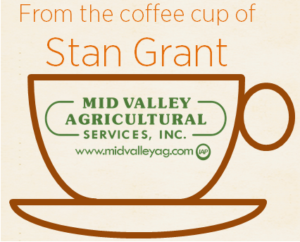
By Stan Grant
We have explored various aspects of water management in vineyards in past Lodi Growers Coffee Shop postings, but we have yet to consider economics, as we will here. For the sake of this discussion, we will assume competent vineyard management, adequate labor, and a primary production goal of sustained maximized profitability. We can, therefore, assume concerted efforts to maintain water application equipment and optimize water resource use.
Vineyard operations incur costs to acquire water. For those growers fortunate to have riparian water rights, there are no direct costs for water, while the costs for ground water are incurred when the well is drilled and developed, and the costs for district water are incurred periodically as bills are received.
There is a significant opportunity to contain the cost of water through maximizing the capacity for storage of moisture received as winter rainfall in vineyard root zones (Fig. 1).
Realizing maximum moisture storage requires a combination of pre- and post-plant measures designed to maximize the depth of the root zone, water holding capacity within the root zone, the rate of water infiltration into the soil, and moisture conservation. Pre-plant soil preparations include the application of mineral amendments to balance calcium with other positively charged minerals for maximum soil particle aggregation, applying organic amendments to increase soil porosity and water holding capacity, and ripping or slip plowing to create a uniformly deep and porous soil reservoir. Annual early season cover crop incorporation is the most important post plant practice for optimizing the hydraulic characteristics of soils and conserving soil moisture from winter rains. These efforts produce side benefits that are difficult to valuate, including reduced surface runoff, soil erosion, and off-site movement of water and soil particles.
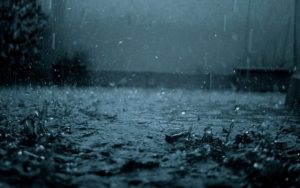
Fig. 1: Making good use of stored soil moisture from winter rain reduces irrigation costs. (longwallpapers.com, 2015)
Irrigation water quality can affect efforts to save water. Water that is too pure will strip minerals from soils (electrical conductivity or EC ≤ 0.2 to 0.5 dS/m). In the process, soil aggregates fall apart and soil porosity declines. As a result, water movement into and through the soil is diminished. Remediation involves adding salts (e.g. gypsum) to the water or soil, which is an additional cost (Fig. 2). At the opposite end of the spectrum are waters laden with high levels of dissolved minerals or salts (EC ≥ 1.0 to 2.7 dS/m). In these situations, plants have a difficult time extracting water from the soil due to osmotic forces. The remedy is applying water in excess of vine requirements to dilute and leach the salts (i.e. a leaching fraction), which requires adequate subsurface drainage.
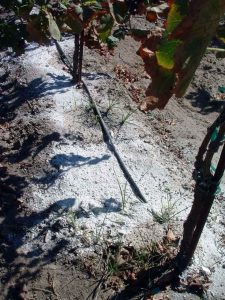
Fig. 2: An in-row gypsum application to enhance soil aggregation, porosity, and water movement into the soil. (Progressive Viticulture©)
Vineyard operations also incur costs to move water. Competent irrigation system designers will select a pump that has the capacity to move the desired amount of water while using the least amount of horsepower and energy (Fig. 3). The horsepower, of course, comes from a power plant, of which there are two options – diesel engines or electric motors.
The least costly power plant option often depends upon the location of the nearest electric power grid or reliable source of diesel fuel. Where both sources of energy are equally available, their relative cost becomes a critical factor. The formulas for comparing the cost per acre-foot of water ($/AF) are 1.58 x total head x $/Kwhr for electric motors and 0.139 x total head x $/gallon for diesel engines. Other cost factors for moving water include power plant installation, initial setup, and relative operating efficiencies. Diesel engines are inherently less efficient than electric motors, have a narrower range of loads near maximum efficiency, and unlike motors, their efficiency depends on weather conditions, elevation above sea level, and age. Moreover, diesel engines require more monitoring and maintenance than electric motors.

Fig. 3: A low horsepower centrifugal pump sufficient to lift water from a ditch and charge a vineyard drip irrigation system. (Progressive Viticulture©)
Vineyard managers can limit the costs of moving water by initiating irrigations only after significant depletion of soil moisture stored from winter rains or after there is evidence, either through visual cues or pressure bomb readings, that vines are under moderate water stress (Fig. 4). They can further reduce applied water through careful timing and allocation of water resources in-season to maintain moderate water stress. Actually, vines under moderate water stress use water more efficiently for growth and development than vines under no stress. In other words, we get more out of our vines per unit water when we carefully regulate water applications through deficit irrigation scheduling. The actual savings range between 28% and 50%, depending on location in California. In addition, through regulated deficit irrigation scheduling, a grape grower can avoid costs associated with excessive canopy growth, foliar disease, damaging leafhopper populations, poor winegrape quality, and other detrimental effects of liberal irrigations.
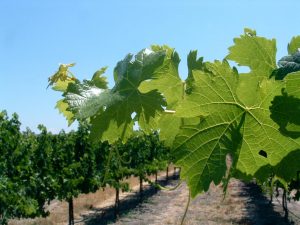
Fig. 4: Shoot growth arrested due to moderate water stress. (Progressive Viticulture©)
In addition to acquiring and moving water, there are costs to distribute water. This includes the initial cost of the irrigation system plus the cost to maintain it. In these regards, surface irrigation systems are less expensive than closed irrigation systems, including drip irrigation systems. Surface irrigation, however, appears much less favorable after including the costs of the soil variability it introduces through pre-plant grading and the direct and indirect costs on soil tilth of repeated in-season tillage. Moreover, drip irrigation has the capacity for frequent, low duration irrigations, which is essential for realizing the savings from deficit irrigation scheduling described above. These factors, along with the added value of precision chemigation, normally render a substantially greater return on investment with drip compared to surface irrigation for in-field water distribution (Table 1).
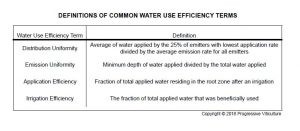
Table 1: Click here to enlarge.
A version of this article was originally published in the Mid Valley Agricultural Services October, 2010 newsletter, and was modified and updated for this blog post.
Further Reading
Goldhammer, DA; Snyder, RL. Irrigation scheduling: a guide for efficient on-farm water management. Univ. Calif. Div. Agric. Nat. Res. Pub. 21454. 1989.
Grant, S. Five-step irrigation schedule: promoting fruit quality and vine health. Practical Winery and Vineyard. 21(1): 46-52 and 75. May/June 2000.
Hanson, B. Irrigation pumping plants. Univ. Calif. Irrigation Program, Davis, 1994.
Hillel, D. Introduction to soil physics. Academic Press, New York. 1982.
Merriam, JL; Keller, J. Farm irrigation system evaluation: a guide for management. Utah State Univ., Logan, 1978.
Prichard, TL. Imposing water deficits to improve wine quality and reduce costs. Proc. Calif. Plant and Soil Conf., 05-06Feb02. Calif. Chap. Amer. Soc. Agron.
Schwankl, L. Irrigating efficiently. In Micro-irrigation of Trees and Vines. Univ. Calif. Irrigation Program, Davis, 1995.
Have something interesting to say? Consider writing a guest blog article!
To subscribe to the Coffee Shop Blog, send an email to stephanie@lodiwine.com with the subject “blog subscribe.”
To join the Lodi Growers email list, send an email to stephanie@lodiwine.com with the subject “grower email subscribe” or click on “join our email list” to the right.
To receive Lodi Grower news and event promotions by mail, send your contact information to stephanie@lodiwine.com or call 209.367.4727.
For more information on the wines of Lodi, visit the Lodi Winegrape Commission’s consumer website, lodiwine.com.
To join the LODI RULES Sustainable Winegrowing Community as a grower or a vintner, email stephanie@lodiwine.com with the subject “LODI RULES.”


